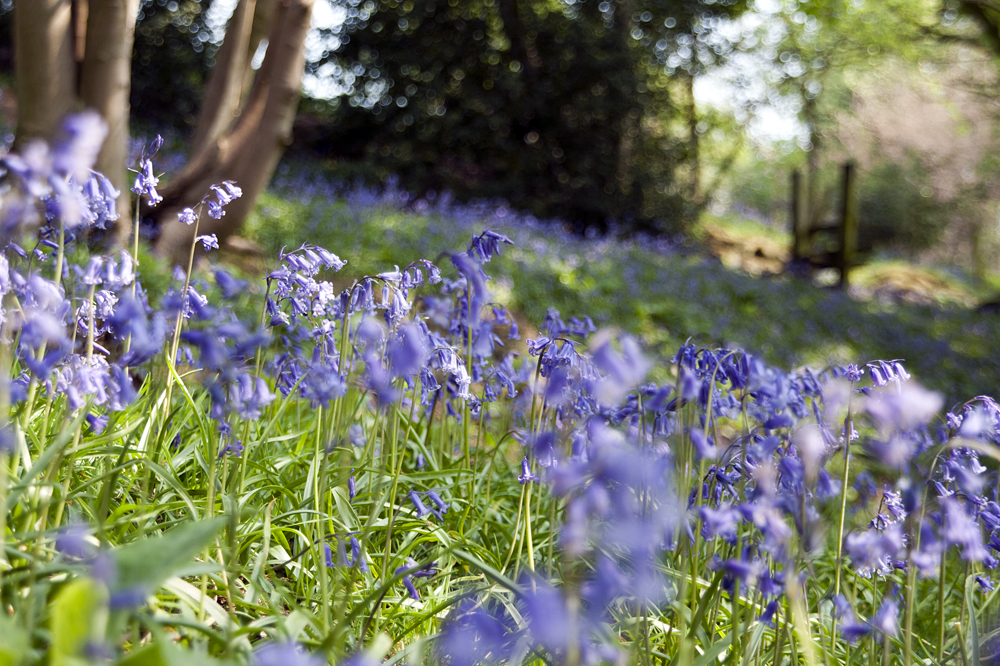Fragrant carpet: Swathes of bluebells dance in the sunlit glades in Bodnick Wood, on Cheshire’s Sandstone Ridge
Throughout the warmer months of the year, walkers on Cheshire’s Sandstone Trail enjoy the wealth of wildflowers that thrive in the varied habitats along the long distance path.
Up on the sandstone ridge, above Frodsham, the woodland paths are edged with celandines, wood anemones and bluebells in spring and early summer. And don’t miss the eye-catching wildflower meadows at Wheeldon Copse, to the east of Alvanley Cliff.
Delamere Forest
In ancient, sun-dappled Delamere Forest, keep a sharp lookout for the orchids and other lime-loving plants that sometimes edge the broader, limestone surfaced tracks. The forest is an ideal place, too, for fungal forays on warm autumn days after rain.
In wetter areas, especially around the back of of Hatchmere, you may be lucky enough to spot insectivorous sundew and butterwort, with bog myrtle nearby.
There are primroses, cowslips, harebells, wild thyme and orchids on Pale Heights and the grassy ramparts of Eddisbury Hill.
Primrosehill Wood, the quieter southern outlier of Delamere Forest, gives walkers another opportunity to enjoy central Cheshire’s wildflowers. In clear felled areas, flushes of spiky foxgloves and rosebay willowherb splash the forest in pink and purple. In sunny areas, there are often patches of blue forget-me-not beside the paths, too.
Green Lanes
The steep, flower-rich banks of delightful Sandy Lane, above Willington, support wildflowers such as primroses, violets, honeysuckle, bluebells, wood anemones, buttercups, stitchwort, cow parsley and wild arum.
Old Gypsy Lane, north of Tarporley, is an ancient green lane with dense hedgerows that support a wealth of plants, birds and butterflies. There are primroses in the hedges in spring and bright yellow marsh marigolds in the ditches. Nearby Oxpasture Wood is awash with wood anemones and fragrant bluebells in early summer.
The stretch of the Trail from Tarporley towards Beeston runs through the green tunnel of the ancient Back Lanes whose hedgerows are full of blackberries, crab apples and sloes in autumn.
Out in the open again, the Trail crosses large fields punctuated with flooded marl pits: fascinating micro habitats that support bulrushes, purple loosestrife, and water lilies.
Beeston Crag
Beeston Crag and its castle walls support unusual plants such as naturalised wallflowers, ivy-leafed toadflax, black spleenwort and polypody fern.
Heather and bilberries dominated Bulkeley Hill until grazing ceased in the 1930s; today it’s a mosaic of remnant heath, bracken, bilberry and scrub birch, with a few large veteran coppiced sweet chestnuts above the eastern slopes. Conifers, opportunist birch and rhododendrons have grown up along the Trail past the highest point at Rawhead, and on down to Chiflik Farm.
Heather and Gorse
The open, sunlit summit of Bickerton Hill is owned and managed by the National Trust for both people and wildlife.
Seasonal grazing by cattle and ponies, combined with ongoing scrub clearance, aim to conserve one of the largest remaining areas of lowland heath in Cheshire. This scarce and declining habitat is a bright patchwork of coconut-scented gorse, heather, ling, bilberry, and birch.
When the Trail descends from the hills at Duckington, it crosses open, undulating country past Hampton Green and No Man’s Heath. Several of the farms adjoining the Trail here run government agri-environment and stewardship schemes that support broad ‘headlands’ around the margins of fields, unimproved pastures and wildflower meadows.


